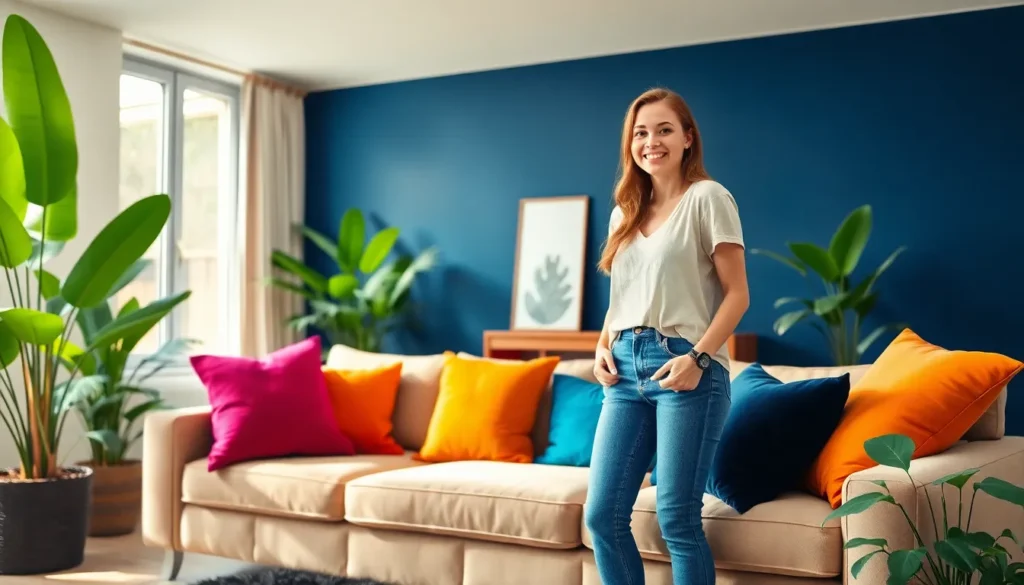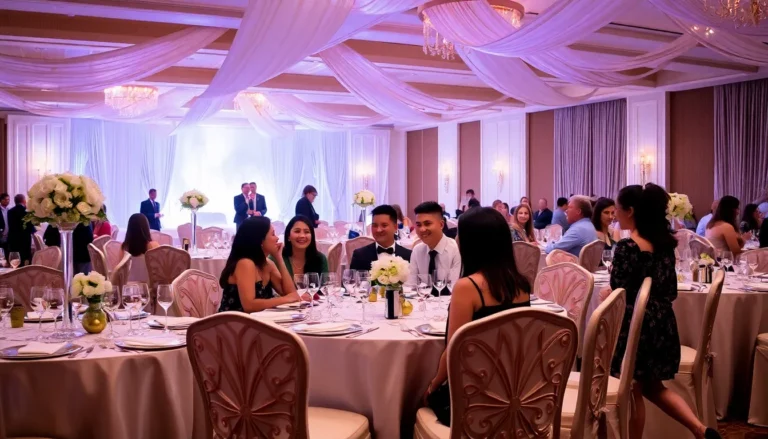Color isn’t just a splash on the wall; it’s the mood, the vibe, and the personality of a space. Imagine stepping into a room painted in vibrant yellows and greens, and suddenly you feel like you’re in a sun-soaked garden party. Now picture a room draped in deep blues and grays—suddenly, it’s all about cozy evenings with a good book. Color can transform an ordinary space into something extraordinary.
Table of Contents
ToggleImportance Of Color In Interior Design
Color significantly impacts interior design by shaping the mood and ambiance of a space. Choices in color strategy can elevate environments, creating spaces that feel vibrant or serene.
Psychological Effects Of Color
Various colors evoke specific emotional responses. For example, warm tones like red and orange inspire feelings of energy and excitement. Cool colors such as blue and green promote calmness and relaxation. Neutral shades provide balance and versatility, making them suitable for any room. Understanding the psychological effects of each color helps designers create spaces that resonate with inhabitants and visitors alike. Utilizing appropriate color choices can lead to enhanced well-being and productivity.
Color Theory Fundamentals
Color theory lays the groundwork for effective color use in design. Primary colors, including red, yellow, and blue, form the basis for all other hues. Secondary colors, derived from mixing primary colors, include green, orange, and purple. Tertiary colors emerge from combining primary and secondary colors, resulting in unique shades. Color harmony, achieved through complementary, analogous, or monochromatic schemes, creates visual balance. Designers can apply these principles to ensure that color selections align with their intended atmosphere and functionality for a space.
Choosing The Right Colors

Selecting the right colors for interior spaces requires a thoughtful approach. Homeowners and designers must consider various aspects to achieve a harmonious look.
Understanding Color Schemes
Color schemes play a crucial role in setting the tone for a space. Designers typically use three primary types: analogous, complementary, and monochromatic. Analogous schemes incorporate colors next to each other on the color wheel, promoting a serene atmosphere. Complementary schemes utilize colors opposite each other to create contrast, adding energy to the room. Monochromatic schemes involve different shades of a single color, emphasizing simplicity and elegance. Each scheme serves a unique purpose, influencing the overall aesthetic and emotional impact of the environment.
Factors Influencing Color Choice
Several factors impact color selection for interior design. Lighting has a significant effect, as natural light can alter how colors appear throughout the day. Room size and shape also influence color choice; lighter shades often make spaces feel larger, while darker tones can create coziness. The intended function of a room further guides decisions; calming hues work well in bedrooms, while energizing colors suit offices or playrooms. Personal preferences, lifestyle, and existing furnishings should also guide the selection, ensuring a cohesive and functional design scheme.
Color Trends In Interior Design
Current color trends in interior design reflect evolving tastes and preferences. Designers frequently explore various palettes to enhance aesthetics and mood.
Popular Color Palettes
Neutral tones often serve as timeless favorites, creating calmness in space. Soft whites, tans, and grays provide versatility and serve as a backdrop for bold accents. Earthy hues, including deep greens and browns, evoke a natural feel and promote tranquility. Bold colors like navy blue, emerald green, and rich burgundy make striking statements and add depth. Bright colors such as sunny yellows and vibrant oranges infuse energy, ideal for social areas. Many designers favor layering multiple shades to create dimension and richness.
Seasonal Color Inspirations
Spring brings pastels into focus, with soft pinks, light blues, and mint greens inspiring lightness and renewal. Summer often showcases vibrant colors, including turquoise and bright coral, reflecting fun and energy. Autumn introduces warm, earthy tones like rust and mustard, which exude warmth and comfort. Winter often shifts to rich jewel tones, such as deep purples and rich reds, adding sophistication and elegance. These seasonal palettes help reflect nature’s changes while enhancing the ambiance of interior spaces.
Techniques For Using Color Effectively
Effectively using color in interior design enhances both aesthetics and functionality. Designers can employ various techniques to create compelling interiors.
Accent Walls
Accent walls serve as focal points in a room, adding depth and interest. Choosing a bold color for one wall establishes contrast while maintaining cohesion with surrounding hues. Opting for a vibrant shade like deep blue or rich green can energize a space, while softer tones like pale gray or light beige provide a more subdued effect. For maximum impact, situate accent walls behind significant features, such as a fireplace or artwork. This approach draws attention and enhances the visual hierarchy. Additionally, consider the room’s function; energizing colors suit creative spaces, while calming shades benefit relaxation areas.
Color Blocking
Color blocking involves using contrasting colors in defined shapes throughout a space. This technique creates a modern, dynamic look. Selecting two or three complementary or contrasting colors can invoke a curated feel. For example, pairing bold yellows with soft blues may brighten an area. Applying this method to furniture, textiles, or even painted surfaces adds personality and vibrancy. Designers often recommend using color blocking in open areas to delineate spaces while reinforcing unity. When applied thoughtfully, this style offers a fresh twist, helping to convey a specific mood or theme within a room.
Color plays a pivotal role in shaping interior spaces and influencing emotions. By understanding the psychological effects of different hues and applying color theory, designers can create environments that resonate with the intended atmosphere. Whether opting for vibrant shades to energize a room or soothing tones for relaxation, the choices made can profoundly affect how a space feels and functions.
Current trends highlight the versatility of color, allowing for personalization and creativity in design. Techniques like accent walls and color blocking offer innovative ways to incorporate color while enhancing aesthetics and functionality. Ultimately, the thoughtful use of color can transform any interior into a harmonious and inviting haven.



